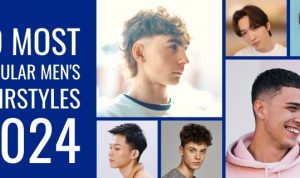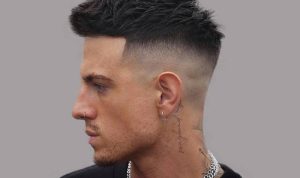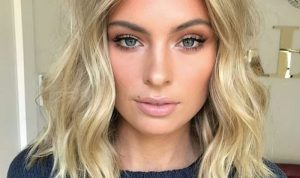Understanding Short, Fine, Thin Hair
Hairstyles for short fine thin hair – Short, fine, thin hair presents unique styling challenges. Characterized by its delicate texture and lack of volume, it requires specific care and styling techniques to achieve a desired look. This hair type often appears limp, lacks body, and can be difficult to style, leading to frustration for many individuals. Understanding its characteristics is the first step towards managing and enhancing its appearance.
Characteristics of Short, Fine, Thin Hair
Short, fine, thin hair is characterized by its fine diameter strands, which often lack body and volume. The texture is typically smooth and straight, although it can also have a slight wave. Common challenges include limpness, a tendency to fall flat, and difficulty holding styles. This hair type can appear sparse or less dense than other hair types.
The lack of volume can be exacerbated by improper styling techniques and the use of heavy products.
Hair Types and Associated Issues
Several hair types fall under the umbrella of short, fine, thin hair. These include straight, fine hair; wavy, fine hair; and even some types of curly hair that are naturally fine and lack density. Individuals with this hair type frequently encounter issues such as limpness, lack of volume, and difficulty achieving desired styles. The hair may also be prone to breakage or damage due to its delicate nature.
The perceived thinness can lead to concerns about hair loss, even if it’s simply a matter of fine texture.
Suitable Hairstyles: Hairstyles For Short Fine Thin Hair
Several hairstyles can effectively create the illusion of more volume and enhance the appearance of short, fine, thin hair. These styles strategically use layering, texture, and strategic cuts to maximize the hair’s potential.
Five Hairstyles for Volume
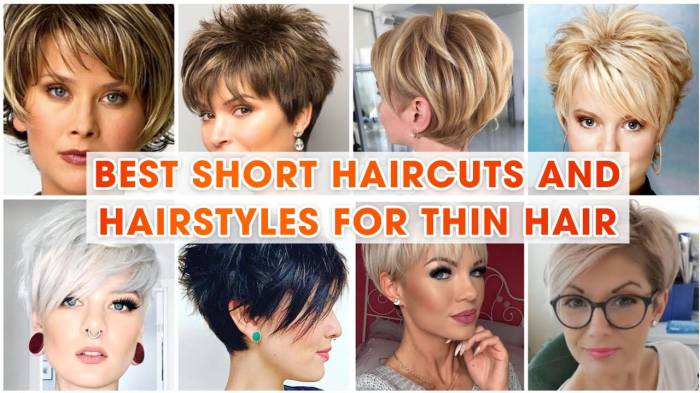
Source: azhairvietnam.com
The following hairstyles are designed to add volume and visual thickness to short, fine, thin hair. Proper styling techniques are crucial for achieving the best results.
- Pixie Cut with Side Swept Bangs: This short, choppy cut creates texture and movement, adding visual interest and the illusion of thickness. The side-swept bangs draw attention away from any areas of thinning and frame the face beautifully. Styling involves using a volumizing mousse at the roots and blow-drying with a round brush to lift the hair.
- Layered Bob: A layered bob adds dimension and movement to fine hair. The layers create subtle volume without weighing the hair down. Styling involves using a texturizing spray and diffusing the hair to enhance the natural wave or curl of the layers.
- Long Pixie with Wispy Layers: This style combines the edginess of a pixie with the length to create soft movement. Wispy layers add texture and dimension, creating the illusion of fullness. Styling involves using a lightweight volumizing spray and air drying or using a low heat setting on a blow dryer.
- Short, Textured Crop: This ultra-short cut is bold and stylish. The textured layers create a tousled, voluminous look that minimizes the appearance of thinness. Styling is minimal; a texturizing paste or wax can be used to define the texture.
- Inverted Bob with Face-Framing Layers: This bob is shorter in the back and longer in the front, creating a flattering shape that adds volume. Face-framing layers add softness and dimension, further enhancing the look. Styling involves using a volumizing mousse and blow-drying with a round brush, focusing on lifting the roots.
Hairstyle Comparison Table
| Hairstyle Name | Description | Best Face Shapes | Styling Tips |
|---|---|---|---|
| Pixie Cut | Short, choppy cut with textured layers. | Oval, heart, diamond | Use volumizing mousse and blow-dry with a round brush. |
| Layered Bob | Shoulder-length cut with varying lengths for volume. | Oval, round, square | Use a texturizing spray and diffuse or air dry. |
| Long Pixie | Longer pixie with wispy layers for movement. | Oval, heart | Use a lightweight volumizing spray and air dry or blow-dry on low heat. |
| Textured Crop | Ultra-short, tousled cut for maximum texture. | Oval, heart, diamond | Use a texturizing paste or wax. |
| Inverted Bob | Shorter in the back, longer in the front for volume. | Oval, round, square | Use volumizing mousse and blow-dry with a round brush, focusing on lifting the roots. |
Hairstyles Minimizing Thinning
Certain hairstyles are particularly effective at minimizing the appearance of thinning hair by creating the illusion of density and fullness. These styles often utilize strategic layering, specific cuts, and clever styling techniques.
- A-Line Bob: The graduated length, longer in the front and shorter in the back, creates a visually fuller look. The longer front sections add weight and volume, masking any areas of thinning.
- Slightly Longer Pixie: A pixie cut that is slightly longer on top allows for more styling options and creates more volume than a very short pixie. The longer top section can be styled to add height and fullness.
- Layered Lob: A long bob with subtle layers adds movement and texture, making the hair appear thicker. The layers should be strategically placed to avoid creating too much weight at the ends, which can flatten the hair.
Styling Techniques and Products
Achieving volume and texture in short, fine, thin hair requires careful selection of styling techniques and products. The goal is to add body and lift without weighing the hair down, maintaining a natural and healthy look.
Volume-Boosting Techniques
Several techniques can add volume without harsh chemicals or damaging heat. These techniques focus on lifting the hair at the roots and creating texture throughout.
Finding the right hairstyles for short, fine, thin hair can be challenging, but there are many stylish options. If you’re looking to add volume and texture, consider exploring ways to enhance your natural curls or try techniques that mimic them. For inspiration on achieving bouncy, adorable looks, check out some fantastic ideas on cute curly hairstyles for short hair , which can offer valuable styling tips adaptable to finer hair.
Ultimately, the goal is to find a style that complements your hair type and enhances your features.
- Root Lifting: Using a volumizing mousse or spray at the roots before blow-drying is crucial. This provides lift and holds the style in place.
- Blow-Drying Techniques: Blow-drying with a round brush, lifting the hair at the roots, adds significant volume. Using a low heat setting minimizes damage.
- Strategic Parting: Experiment with different partings to find one that maximizes volume. A side part often creates more lift than a center part.
- Texturizing Products: Using texturizing sprays, pastes, or mousses adds grip and texture, preventing the hair from falling flat.
Hair Products for Fine Hair
Choosing the right hair products is essential. Lightweight formulas are key to avoid weighing down fine hair. Avoid heavy conditioners or oils that can flatten the hair.
- Volumizing Mousse: Applies at the roots to lift and add body.
- Volumizing Spray: Provides lift and texture without stickiness.
- Texturizing Spray: Adds grip and separation to create a fuller look.
- Lightweight Leave-In Conditioner: Provides moisture without weighing down the hair.
Styling Tool Comparison
Different styling tools have varying effects on short, fine, thin hair. Selecting the right tool depends on the desired outcome and hair type.
- Round Brushes: Excellent for adding volume and creating lift at the roots during blow-drying.
- Curling Irons (Small Barrel): Can create loose waves or curls to add texture and volume, but should be used sparingly to avoid damage.
- Diffusers: Best for enhancing natural waves or curls without causing frizz. They help to define the curls while adding volume.
Hair Care Routine
A consistent hair care routine tailored to short, fine, thin hair is essential for maintaining its health and appearance. This routine should focus on gentle cleansing, proper conditioning, and healthy drying techniques.
Weekly Hair Care Plan
This plan Artikels a weekly hair care routine to maintain healthy, voluminous short, fine, thin hair.
- Washing (2-3 times per week): Use a gentle, volumizing shampoo and conditioner designed for fine hair. Avoid over-washing, which can strip natural oils and lead to dryness.
- Conditioning: Apply conditioner only to the ends of the hair to avoid weighing down the roots. Use a lightweight conditioner.
- Drying: Gently towel-dry your hair, avoiding harsh rubbing. Air-dry whenever possible or use a low heat setting on your blow dryer.
- Scalp Care: Massage your scalp gently during shampooing to stimulate blood flow and promote healthy hair growth.
- Deep Conditioning (Once a week): Use a deep conditioning mask once a week to add moisture and repair any damage.
Scalp Health, Hairstyles for short fine thin hair
Maintaining a healthy scalp is crucial for healthy hair growth. A healthy scalp provides the optimal environment for hair follicles to thrive.
- Regular Cleansing: Regularly cleanse the scalp to remove product buildup and excess oil.
- Scalp Massage: Regular scalp massage stimulates blood circulation and promotes healthy hair growth.
- Healthy Diet: A balanced diet rich in protein, vitamins, and minerals is essential for healthy hair growth.
Common Hair Care Mistakes
Several common mistakes can worsen the condition of short, fine, thin hair. Avoiding these mistakes can significantly improve its health and appearance.
- Over-Washing: Stripping natural oils leads to dryness and breakage.
- Using Heavy Products: Weighs down the hair and diminishes volume.
- Harsh Towel Drying: Causes breakage and frizz.
- Excessive Heat Styling: Damages the hair and makes it prone to breakage.
Visual Examples
Visualizing different hairstyles and color choices is crucial for understanding how to enhance short, fine, thin hair. Specific details, like layering and fringe, play a significant role in the overall look and perceived volume.
Detailed Hairstyle Descriptions
- The Textured Pixie: This pixie cut features short, choppy layers throughout, creating a textured, voluminous look. The layers are shorter on the sides and slightly longer on top, adding height and movement. A subtle fringe adds softness to the face, and the overall effect is one of playful, effortless volume. The light catches the different lengths of the layers, enhancing the textured appearance.
- The Layered Bob with Side Swept Bangs: This shoulder-length bob incorporates subtle layers that add movement and body without weighing the hair down. The layers are longer in the front and shorter in the back, creating an A-line shape that further enhances volume. The side-swept bangs soften the face and draw attention away from any potential thinning. The light plays beautifully across the layers, creating depth and dimension.
- The Inverted Bob with Highlights: This short bob is shorter at the back and gradually gets longer towards the front, creating a visually fuller effect. The addition of strategically placed highlights adds dimension and depth, making the hair appear thicker. The highlights catch the light and create a sense of movement, making the hair look more voluminous. The overall effect is sleek, chic, and full of body.
Hair Color and Volume Perception
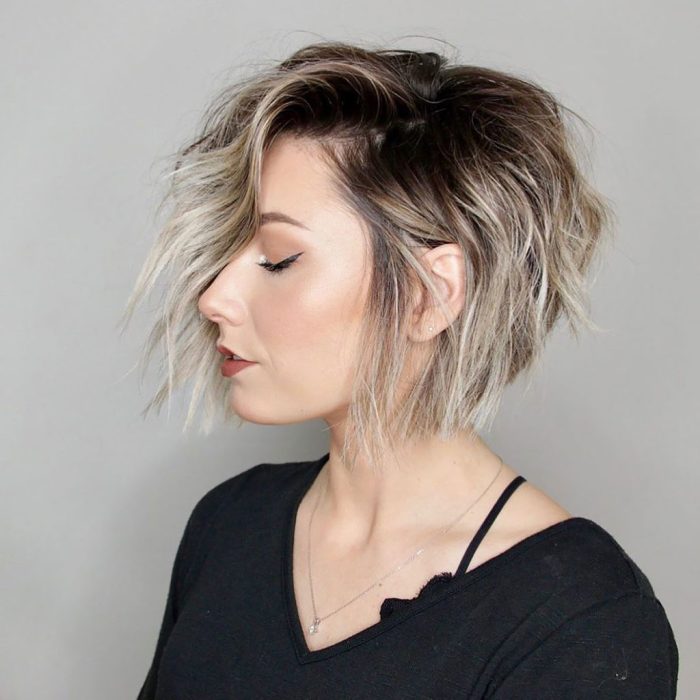
Source: cloudfront.net
Hair color significantly impacts the perceived volume of short, fine, thin hair. Darker shades tend to make hair look denser, while lighter shades can make it appear finer. Strategic highlights and lowlights can add depth and dimension, creating the illusion of thickness.
Colors for Fuller Hair
Certain hair colors create a more voluminous look. These colors play with light and shadow to enhance the appearance of thickness.
- Dark Brown: The deeper tones create shadows that give the illusion of density.
- Auburn: Warm tones add richness and depth, enhancing texture.
- Warm Blonde (with subtle highlights): The lighter color adds brightness, while strategically placed highlights create dimension and volume.
- Chocolate Brown: Rich and deep, this color creates a sense of density and fullness.
- Mushroom Blonde: A muted blonde shade that adds depth and texture without being too harsh.
Questions Often Asked
Can I use heat styling tools daily?
While heat styling can create volume, daily use can damage fine, thin hair. Limit use and always apply a heat protectant spray.
How often should I wash my hair?
Washing too often can strip natural oils, leading to dryness and breakage. Aim for every other day or every 2-3 days, depending on your scalp’s oil production.
What’s the best way to dry my hair?
Air drying is gentler, but if you use a hairdryer, use a low heat setting and a diffuser attachment to minimize damage and maximize volume.
Are there any specific vitamins good for hair growth?
Biotin, Vitamin D, and iron are often associated with hair health. Consult a doctor or nutritionist to determine if supplementation is right for you.

